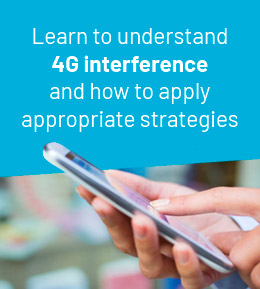Contents
Understanding 4G interference: What is it and how does it affect our connectivity?
In today’s era of mobile communication, 4G or LTE technology has become an integral part of our lives. It allows us to stay connected at all times, access high-speed Internet and enjoy a wide range of services on our mobile devices. However, despite technological advances, 4G interference can affect our connectivity experience. In this article, we will explore what exactly 4G interference is and how it can affect our connectivity in the digital world we live in.
 What is 4G interference?
What is 4G interference?
4G interference refers to disturbances or unwanted signals that affect the wireless communication of the 4G network. This interference can be caused by a variety of factors, such as nearby radio frequency sources, physical obstacles, interference from other networks or even network overload due to a high concentration of connected devices. These interferences can weaken the 4G signal, resulting in lower connection quality and slower data transmission speeds.
Factors contributing to 4G interference:
Radio frequency interference:
Radio frequency signals emitted by nearby electronic devices, household appliances, electric motors or other wireless transmission equipment can interfere with the 4G signal, weakening it and affecting connection quality.
Physical obstacles:
Buildings, walls, trees and hilly terrain can act as physical obstacles that attenuate the 4G signal. These obstacles can block or scatter the signal, resulting in poor connectivity and slower data rates.
Interference from other networks:
Wi-Fi networks, Bluetooth networks or other mobile networks operating in the same or nearby frequency bands may generate interference to the 4G signal. This can occur when there is electromagnetic interference between different networks, which negatively affects signal quality and connection speed.
Network overload:
In densely populated areas or at crowded events, a high number of simultaneously connected devices can put pressure on the capacity of the 4G network. This overload can lead to network congestion, resulting in lower quality of service and slower data speeds for users.
Impact on our connectivity:
4G interference can have various impacts on our connectivity and online experience. Some of these impacts include:
Signal loss:
Interference can cause a total or partial loss of 4G signal, resulting in temporary disconnection or frequent interruptions in connection.
Slower data speeds:
Interference can slow down data transmission speeds, which means that downloads, video streaming and other online activities can become slower and more uncomfortable.
Poor connection quality:
Interference can affect signal quality, which can manifest itself in choppy phone calls, poor voice quality in communications and general connectivity problems.
Poor user experience:
4G interference can result in an unsatisfactory user experience, especially when dealing with applications that require a stable and fast connection, such as online gaming, video calls or streaming services.
Improving Signal Quality: How to Minimize 4G Interference
In our daily lives, 4G signal quality is crucial to enjoy fast and reliable connectivity on our mobile devices. However, 4G interference can negatively affect signal quality and diminish our online experience.
 In this article, we will explore various strategies and tips to minimize 4G interference and improve signal quality on our mobile network.
In this article, we will explore various strategies and tips to minimize 4G interference and improve signal quality on our mobile network.
Locate your device close to the antenna:
An effective way to improve 4G signal quality is to place your mobile device as close as possible to the network antenna. Antennas are often located in strategic locations, such as on top of buildings or on telecom towers. By moving closer to these antennas, you will reduce the signal distance and improve reception, resulting in better connection quality.
Avoid sources of interference:
Identify and avoid sources of interference that may affect the 4G signal. Some nearby electronic devices, such as microwave ovens, cordless phones, baby monitors, older Wi-Fi routers and other electronic equipment can generate electromagnetic interference. Keep your mobile device away from these devices or turn them off temporarily to avoid possible interference.
Use signal boosters:
Signal boosters, also known as repeaters or coverage amplifiers, can be an effective solution to improve 4G signal quality in areas with a weak signal. These devices pick up the existing signal and amplify it, allowing for better reception on your mobile device. Be sure to choose a signal booster that is compatible with the 4G network and follow the manufacturer’s instructions for proper installation.
Update your mobile device and firmware:
Keeping your mobile device up to date with the latest operating system version and firmware updates is important to improve signal quality. Manufacturers often release updates that include improvements in signal reception capabilities and bug fixes related to connectivity. Make sure you are aware of the updates available for your device and apply them regularly.
Check network settings:
Check the network settings on your mobile device to make sure they are optimized for better signal quality. For example, check that the “LTE Only” or “4G Only” option is enabled, which will ensure that your device connects specifically to the 4G network rather than looking for weaker connections such as 3G or 2G. Consult your device’s manual or contact the manufacturer’s technical support for more details on optimal settings.
Consider the location of the provider’s antenna:
If you consistently experience signal problems in a specific area, you may want to investigate the location of your mobile service provider’s antenna. If the antenna is far away or blocked by physical obstacles, signal quality is likely to suffer. In some cases, switching wireless service providers may give you better coverage in your area.
Contact your wireless service provider:
If interference persists and you experience consistently poor signal quality, it is advisable to contact your mobile service provider. They will be able to perform a coverage assessment in your area and provide additional assistance. In some cases, they may be able to adjust the network infrastructure to improve signal quality at your location.
4G interference in urban environments
Urban environments are filled with a plethora of electronic devices, communication networks and physical obstacles, making 4G interference more common in these areas. In this article, we will explore the specific 4G interferences found in urban environments and how they can affect signal quality and connectivity in these densely populated locations.
Mobile device density:
In urban environments, the number of mobile devices in operation is very high. All these devices compete for bandwidth and can generate interference with each other. Network congestion can lead to a decrease in signal quality and a reduction in data transmission speeds.
Network congestion:
In urban areas, the network infrastructure can become overloaded due to high user density. During peak hours or mass events, data demand can exceed network capacity, resulting in significant congestion. This results in lower signal quality and a decrease in connection speed.
Electromagnetic interference:
Urban environments are full of sources of electromagnetic interference, such as buildings, power lines, traffic signals and public transportation systems. These elements can block, reflect or scatter 4G signals, resulting in a weakened signal and lower connection quality.
Physical obstacles:
Tall, dense buildings and urban structures in general can obstruct 4G signals. Building walls and metal structures can attenuate the signal and reduce its range. In addition, moving objects such as vehicles and people can also interfere with signal propagation.
Interference from other networks:
In urban environments, there are a large number of wireless networks in operation, such as Wi-Fi, Bluetooth and other mobile networks. When these networks operate in the same or nearby frequency bands as the 4G network, they can generate interference and affect signal quality.
Distance attenuation:
Signal attenuation is more pronounced in urban areas due to the large number of obstacles and the greater distance between users and telecommunication towers. The farther away a user is from an antenna, the greater the likelihood of signal weakening and interference.
Solutions for interference in urban environments:
Deploy more antennas: Deploying additional antennas in urban areas can improve coverage and reduce interference. This can help balance network load and provide better signal quality in densely populated areas.
Use of advanced technology:
The implementation of advanced technologies, such as Multiple-Input Multiple-Output (MIMO) and beamforming, can improve the ability of 4G networks to manage interference in urban environments. These technologies enable better signal reception and transmission, which helps mitigate the effects of interference.
Increased network capacity:
Mobile service providers must expand and improve the capacity of their networks in urban areas to cope with the growing demand for data. This involves investing in network infrastructure, such as additional telecom towers and equipment upgrades, to ensure reliable, high-quality connectivity.
In conclusion, the three issues related to 4G interference addressed in this article provide us with a broader understanding of this problem and how it affects our mobile connectivity:
-
- 4G interference:
-
- These interferences can be caused by various factors, such as network congestion, electromagnetic interference and physical obstacles. They have a direct impact on signal quality and can result in a slower connection, poor voice quality on calls, connectivity issues and poor user experience.
-
- Improving signal quality:
-
- To minimize 4G interference, it is possible to take steps such as locating the mobile device close to the network antenna, avoiding sources of interference, using signal boosters, keeping devices up to date, and optimizing network settings. These strategies can help improve signal quality and ensure a smoother and more satisfying connectivity experience.
-
- 4G interference in urban environments:
-
- Urban environments present additional challenges due to the high density of mobile devices, network congestion, electromagnetic interference and physical obstacles. To address these interferences, it is important to deploy more antennas, use advanced technologies such as MIMO and beamforming, and improve network capacity in urban areas.
-
- 4G interference:
Overall, by understanding 4G interference and applying appropriate strategies, we can minimize its impact on our mobile connectivity and improve signal quality in different environments. Staying informed about interference and being aware of available solutions will allow us to enjoy a smoother, faster and more reliable online experience on our mobile devices.







